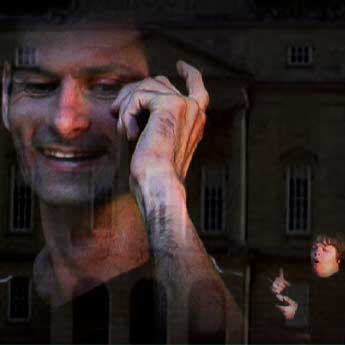| SIGNS OF LIFE :-)
(SOL) feels like a culmination (not end) in a personal learning process about Deaf Culture.
It is a film about something caught out of the corner of the eye. Somehow, it reflects on a universal human spirit - something about joy, something about life and laughter, something as to how all these things are bound up in what we call "communication".
At first, I dug around for information about "outdoor" projections - not theoretical information, just practical.
It seems that users of large scale outdoor images often design their displays around the statistic that viewers will spend a maximum of 10 seconds* looking at any large scale image on the street.
* source Promotional Resource Guidelines, ViewPoint Screen, A large LED (light emitting diode) screen owned by Adshel and used for advertising, public art and information
In the initial workshop at Twerton Village Hall, where this film was made, we first discussed this concept of making a film for outdoor projection onto a building.
This led on to talking about the differences between seeing that, and watching a film in the cinema, or at home on television.
I explained how technically, a black background could be used to make the "frame" of the projection disappear.
Which meant we could try to make a film where people and/or things just appeared on the building, using video black as the background to make the projection frame invisible.
Over the next few weeks, we shot footage of everyone in front of a black backdrop, and we looked at how these images could be manipulated with special effects such as superimposition, double exposure, mirroring, multiple, upside down images and more.
This got everyone thinking about what we could do with special effects, and about any audience passing by these images appearing on the wall of a building somewhere.
We didn't have a lot of time to plan a story, and we were experimenting on the hop. We only had 10 two hours sessions, out of which each person had an hour as part of a small group to work with the video camera and me.
As the weeks developed, I asked everyone to try to wear black clothing so that our footage could concentrate on movement and actions, and we could play around more with manipulating the footage we were shooting.
One session, in came Henry, dressed in full clown costume (a very well dressed clown, I should add - tuxedo and tails with banana boots and makeup). He also had a wonderful colour photo of himself at a clown convention, with hundreds of other clowns, sitting in the center ring of a Big Top circus tent.
I was only amazed.
Now, a clown is not a simple image, a clown is a metaphor, a foil, not just a "fool".
At the same time, a clown is also an "archetype" and as such exists in our understanding as more than simply the definition of a word in a language.
That was just one of many surprises and revelations that began to take place, as each person started to relax and reveal themselves to me and the camera.
However, as you see in the film, not everything is "slapstick" funny. The large hand waving across the screen for example, is a kind of chapter turn in the film, a moment to relax the eye before returning to the busy image.
Like wiping the stage clean to start again. This film is an attempt to portray incidental personal moments, yet one friend asked, after seeing the film:
"Are they a theatre company?"
The nature of outside projection is partly to catch the eye of passers by, not to entertain an audience sat down in a cinema.
For a filmmaker, committing the overall concept to post production manipulation of snapshots or vignettes entails taking longer (i.e. reworking everything through a special effects and "no-image frame" editing concept) In "Signs of Life :-)" none of the shot footage remains in its original state -this is one of the advantages of digital filmmaking.
Under the condition of small budget and limited schedule, this film could not have been made without it being shot and edited digitally. Even so, this film has taken a long time, and often felt more like constructing an animation than conventional filmmaking.
After all, trying to capture the glimpse you had of something, is often harder than seeing what is staring you in the face.
Mac Dunlop 28/8/03
With thanks to Statement Media Arts, Eshoda Arts, Annie Lovejoy, the RNID Outreach Team, and B&NES Adult and Community Education.
Special thanks to: all the participants from Poolemead.
return
|
